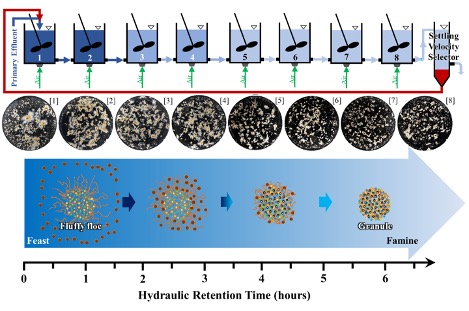11/26/2020 Congratulation on Yewei’s new publication in STOTEN out of a successful collaboration between VT, GMU, and UOSA


Dynamic response of aerobic granular sludge to feast and famine conditions in plug flow reactors fed with real domestic wastewater
ABSTRACT: Plug flow reactors (PFRs) approximated by the connection of multiple completely stirred tank reactors (CSTRs) in series were used to achieve continuous flow aerobic granulation in real domestic wastewater. This study revealed, possibly for the first time, that the morphology and characteristics of aerobic granular sludge transformed in the course of a mixed liquor flow through a PFR. The feast zone, located at the front end of the PFR, can quickly develop filamentous structure on the surface of aerobic granular sludge which later disappeared in the famine zone at the back end of the PFR. Detention time from the front to the back end of the PFR was only 6.5 hours. During this period the observed sludge morphological change led to sludge settleability fluctuation as much as 66% in zone settling velocity, 16% in specific gravity, and 40% in settled sludge volume. Further analysis revealed these types of sludge morphologies and characteristics were closely related to the specific substrate removal rate profiles of the PFR, i.e., the feast zone might have encouraged filamentous bacteria to extend outward into the bulk solution for soluble substrate, and the famine zone appeared to play an essential role in solidifying the structure of granular sludge structure prior to subjecting it to the gravity selection pressure. It can be inferred from this study that the lack of a famine zone in aerobic granulation reactors can loosen the granule structure and in turn deteriorate granule settleability. For a PFR, a famine zone following the feast zone is essential for maintaining the structural integrity of aerobic granular sludge in a continuous flow wastewater treatment system.


